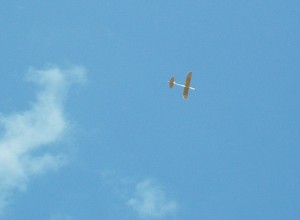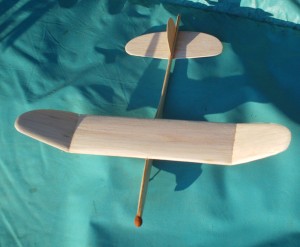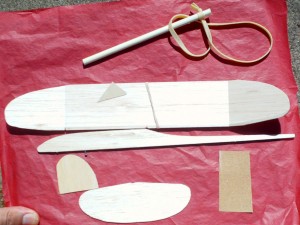Catapult gliders combine two vastly differing flight modes, a rocket like acceleration launch and a slow floating glide. If you are the really impatient type of person, you do not even need to spend the ½ a minute needed to wind up a rubber motor, just pull back and let it rip. But be forewarned your glider needs to be adjusted correctly or it could be hitting the ground quicker than you can blink an eye.
My experience with catapult gliders started with putting a launch hook on hand launch gliders I had built. Launching a glider with a hand toss takes a strong coordinated throw; stretching back an elastic band will be easier for most people. The trick is to get the glider to get as high as possible and transition smoothly into the slow glide. Since the velocity component of the lift equation is squared, your glider in high-speed mode will easily do loops on launch unless you adjust the trim and launch angle correctly. This is explained in the Sparrow instructions.
Lloyd Shales the designer of the Minnow rubber powered plane also designed the Sparrow catapult glider. I purchased two of the kits in the first run from Darcy Whyte inventor of the Squirrel model airplane. The kit not only has laser-cut pieces but the wing had an airfoil shape that just needed some additional sanding to be perfect. Total construction time must have been less than an hour. The last catapult glider I built was The Stinger which is smaller but had no pre-shaping in the wing. It flies well but the glide was not as good as the Sparrow, both gliders are pictured in bottom picture. Small gliders like the Sparrow normally will not break on a crash landing because the inertia is low.




http://inventorartist.com/product/sparrow-catapult-plane/ This appears to be a good link to purchase the Sparrow glider.
How do I purchase a sparrow laser cut glider kit?
Thanks
Dan
L
Like to purchase a sparrow glider kit.
Hi Darryl,
You can order Sparrow glider kits from Darcy at http://inventorartist.com/product/sparrow-catapult-plane/
Gary